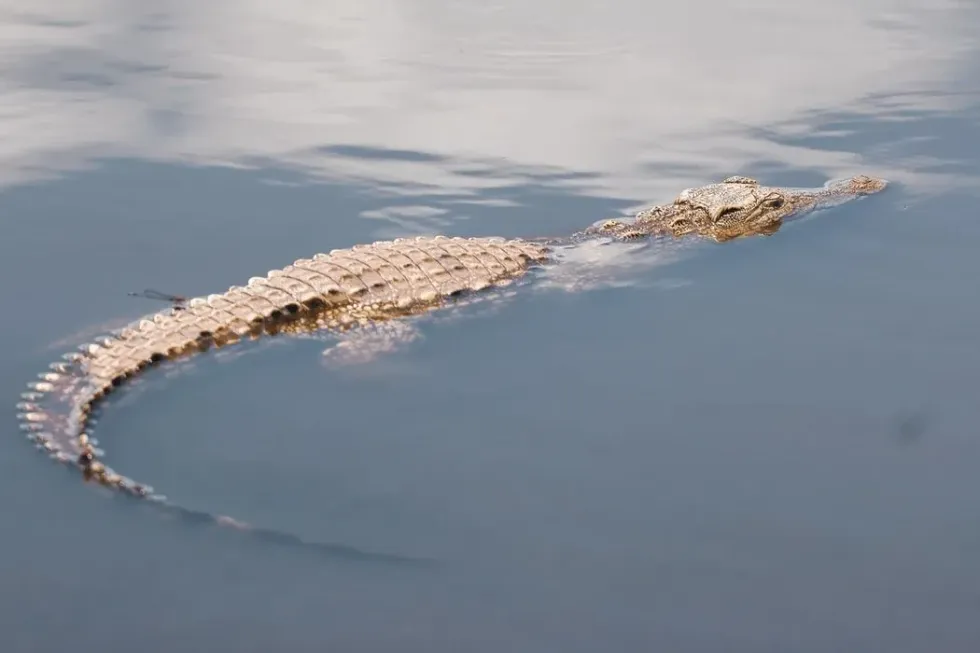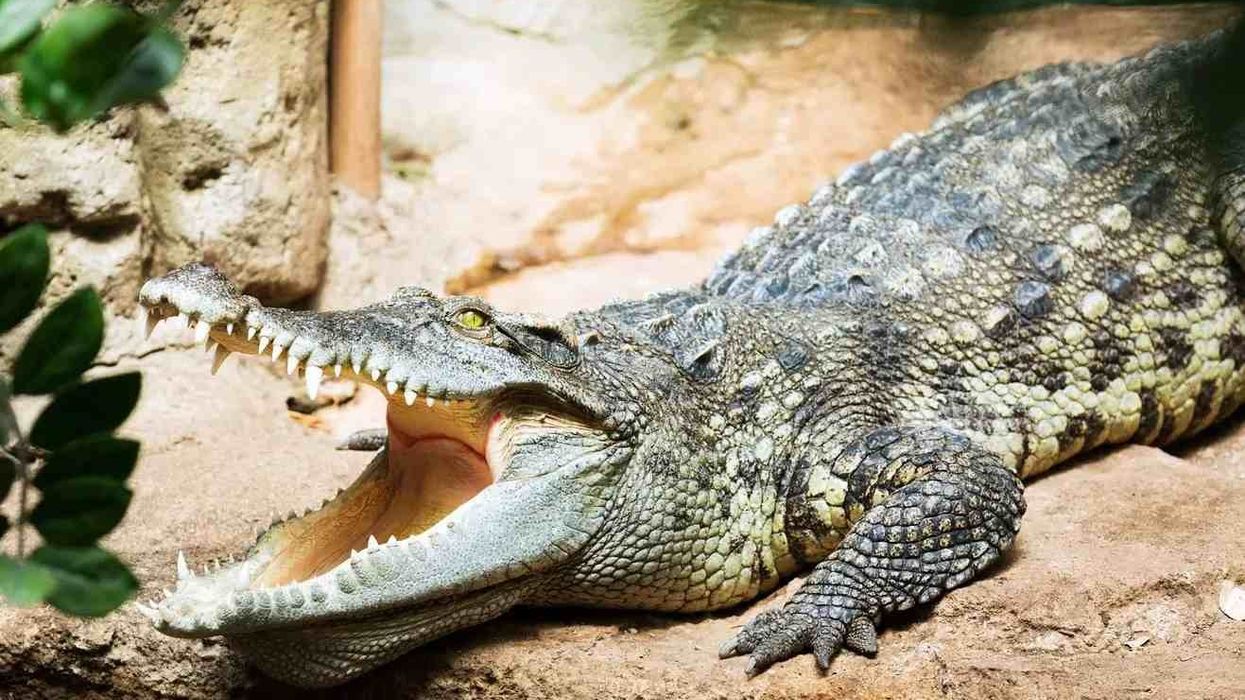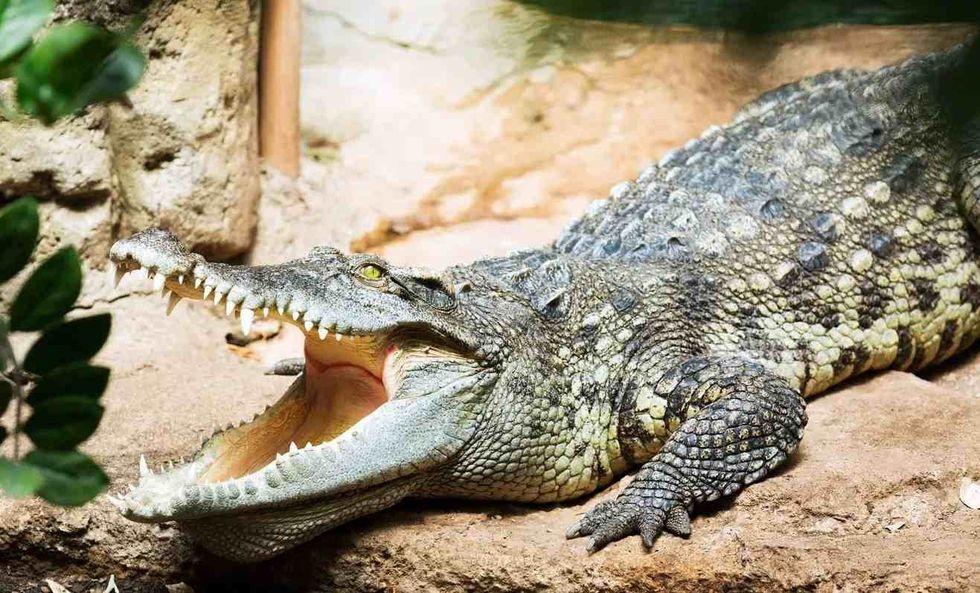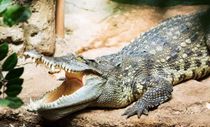Fun Siamese Crocodile Facts For Kids

The Siamese crocodile (Crocodylus siamensis), commonly called the Siamese freshwater crocodile, the soft-belly, and the Singapore small-grain, is a freshwater crocodile found in Indonesia, Vietnam, Cambodia, Myanmar, East Malaysia, Brunei, Thailand, and Laos. It is indigenous to Southeast Asia (Vietnam, Laos, Cambodia, and Thailand).
They are an endangered species, classified as ‘Critically Endangered' in IUCN's Red List, and are at risk of becoming extinct in several areas.
This species is a freshwater crocodile of small-medium size, with a long, sleek snout and an elevated, hard crest behind the eyes. This olive-colored Siamese crocodile is a crocodilian species that breeds in the wet season.
They like to live in freshwater in the wild, but many of these Siamese crocodiles (Crocodylus siamensis) are also found in captivity in crocodile farms.
Those living in the wild are among the most vulnerable crocodiles found in the wild. For the conservation of these populations, many hybrids of this species are being created in captivity in farms in Thailand and Vietnam.
Continue reading for more fascinating and entertaining facts about these stunning Siamese crocodiles (Crocodylus siamensis). You can also discover facts about crocodiles and the dwarf crocodile here on Kidadl if you liked reading about the Siamese crocodile!
Siamese Crocodile Interesting Facts
What type of animal is a Siamese crocodile?
Siamese crocodiles are freshwater crocodiles of the class Reptilia, found in the wild, near freshwater reserves. They were once assumed as extinct in the wild, but luckily, they were then discovered in Cambodia. They can be seen commonly on crocodile farms or in national parks in Thailand, Vietnam, and China. They are indigenous to Southeast Asia.
What class of animal does a Siamese crocodile belong to?
Crocodylus siamensis belong to the class Reptilia. The Siamese crocodile is among the world's least researched and most endangered crocodilians, having been extinct in 99% of its original habitat.
How many Siamese crocodiles are there in the world?
The Siamese crocodile is among the world's least researched and most endangered crocodilians, and it has been extinct in 99% of its original habitat.
They were presumed to be nearly extinct until researchers reported the existence of 200-400 Siamese crocodiles in total in southwest Cambodia, including in the Cardamom Mountains. Today there are approximately 30 places in Cambodia where wild Siamese crocodiles have been found, as well as a small population in Thailand.
On top of this, there is a tiny population in Vietnam (less than 100 ), about 200 in the Cat Tien National Park, a considerable population in Laos, and a nest of young crocodiles in Savannakhet.
Where does a Siamese crocodile live?
The highly fragmented Siamese crocodile's population lives in crocodile farms, national parks. They are usually seen in captivity but they can also be observed in slow-moving rivers and lakes, marshes, forests, and swamplands, among other freshwater habitats.
This species of the genus Crocodylus is critically endangered and thus they are virtually extinct in the wild. Much of Southeast Asia was home to the Siamese crocodile (Crocodylus siamensis) when it had its highest population.
What is a Siamese crocodile's habitat?
Except for in Cambodia, the population of wild Siamese crocodiles is now on the verge of being extinct in the wild. Cambodia, Indonesia, Malaysia, Laos, Vietnam, Thailand, Brunei, and Burma were once home to this species.
A typical Siamese crocodile habitat was found in slow-moving rivers and lakes, marshes, forests, and swamplands, among other freshwater habitats. Today, more commonly, you can see them on a farm or in a national park like the Cat Tien National Park. Adult
Who do Siamese crocodiles live with?
Both males and females in the Siamese crocodile's wild population care for newly hatched offspring, and this crocodile species is the only one to live in a family structure. Siamese crocodiles are territorial, they thump on the water with their heads and bang their jaw on the water's surface to mark their territories.
Dominant crocodiles swim higher in the water, while other members of the same genus swim lower in the water to signal submission.
Dominant crocodiles have a monopoly over food, mates, and the best nesting, wallowing, and living sites. This species uses noises, motion, poses, contact, and odors produced by their four scent glands to communicate.
How long does a Siamese crocodile live?
Both in the wild or in captivity (like a farm or national park), this crocodile has a lifespan of 25 to 35 years. Depending on the climate, temperature, and habitat, males and females can reach different ages.
The majority of these critically endangered crocodiles do not reach maturity and become prey for predators in the wild. Thus their wild population is extremely low.
How do they reproduce?
Siamese crocodiles breed during the wet season, which lasts from April to May. These crocodiles partake in polygyny breeding, meaning that a single male will mate with several females.
In the nests that the female crocodile digs, she lays between 20 and 50 eggs. The eggs are held at the correct temperature in the nest and these eggs take about 80 days to incubate during the wet season.
Many institutions' captive breeding efforts have been fairly successful, and numbers of these crocodiles in captivity have risen significantly. We hope that future breeding efforts thrive as well so that populations increase further as this species is currently classified as Critically Endangered in the IUCN's Red List.
What is their conservation status?
According to the IUCN (International Union for Conservation of Nature) Red List, the overall number of adult Siamese crocodiles is between 500 and 1000. The World Wildlife Fund estimates that its population is between 100 and 300 wild adults in Cambodia.
These crocodiles are officially listed as Critically Endangered, and their numbers are declining.
Hybrids between Siamese and Cuban crocodiles or Siamese and saltwater crocodiles have also been developed resulting in the saltwater Siamese crocodile hybrid and the Cuban Siamaes crocodile hybrid. In Thailand, Cambodia, and Vietnam, Siamese crocodiles were farmed for their meat and skin but now this species is extensively protected and is raised in captivity for its conservation.
Siamese Crocodiles Fun Facts
What do Siamese crocodiles look like?
They are crocodiles of medium size, about 118 in (300 cm) long. They have a big head in addition to their large size, as well as bulging eyes and nostrils.
Its legs feature five fingers on the front legs and four fingers on the back ones. Their forelimbs are longer than their hindlimbs and they have lines on their body that alternate between olive and brown in color. These crocodiles, in their infancy, have a yellow-brown color with black streaks and spots on their body.

* Please note that this is an image of a crocodile, not a Siamese crocodile specifically. If you have an image of a Siamese crocodile please let us know at hello@kidadl.com.
How cute are they?
They are olive green colored and have broad snouts and throats. Their big head in contrast with their body, and sticking-out eyes and nostrils make them the antithesis of cute.
How do they communicate?
Crocodiles use noises, motion, poses, contact, and odors produced by their four scent glands to communicate. When hatchlings are in distress, they will cry out to parents, and they are very vocal when being fed. Adults usually create a loud, deep, repetitive roar, which other adults imitate.
How big is a Siamese crocodile?
The Siamese crocodile is a freshwater crocodile with an elongated, smooth snout and a bony crest behind its two eyes. Females can grow as tall as 10 ft (3.2 m) and males can grow to be 13 ft (4 m) tall.
The average adult is less than 10 ft (3 m) tall. They are half the size of an average saltwater crocodile.
How fast can a Siamese crocodile move?
They can move as fast as 10-17 miles per hour (4.7-8 meters per second).
How much does a Siamese crocodile weigh?
This species can weigh from 88-154 lb (40-70 kg).
What are their male and female names of this species?
The male crocodile is called a bull and the female crocodile is known as a cow.
What would you call a baby Siamese crocodile?
A baby Siamese crocodile is called a hatchling. After birth, these hatchlings stay with their mother for safety purposes.
What do they eat?
Siamese crocodiles are carnivorous and feed on mostly fish, but also on snakes, amphibians, and small mammals. As well as being predators they are also often prey.
For example, older crocodiles can be slaughtered and devoured by leopards or jaguars. The green anaconda is also a predator of this species. Young hatchlings have a large number of predators like eagles, wild pigs, herons, and egrets and they are very vulnerable.
Are they poisonous?
No, these crocodiles are not poisonous.
Would they make a good pet?
No, they shouldn't be kept as a pet. They are usually kept in captivity on farms which can lead to an improvement in their life span. They must only be handled by qualified and experienced individuals.
Did you know...
Siamese crocodiles even have their own symbol called the Siamese crocodile symbol. This symbol is believed to symbolize unity and democracy.
Since this crocodile used to be hunted for its skin, it became almost extinct in the wild.
If they lose a tooth, it is replaced really quickly. This is why a crocodile can have about 8000 teeth in its lifespan!
Their blood has anti-microbial characteristics.
The majority of Siamese crocodiles living in captivity are actually hybrids.
They like to build burrows and they rarely tackle large prey. They prefer to feed on small animals like fish, snakes, and amphibians.
The Philippine crocodile is the rarest crocodile!
Why are Siamese crocodiles endangered?
Siamese crocodiles have a conservation status that declares them to be a Critically Endangered species. Human actions, conversion of rainforest habitat to agricultural use, and capture or drowning in fish traps are all threats to this crocodile.
Adult females are also still hunted for crocodile farm stock in Cambodia which has resulted in a decline in the population of the species. In 1992, people assumed the species had gone extinct but thankfully they re-appeared in 2000.
How has the Siamese crocodile adapted
Crocodiles have body armor that helps them to keep themselves safe from predators. This species has powerful jaw muscles which help to crush their prey's bones.
They also possess a strong immune system which helps them in combating infections. They can regulate their body temperature well and they can even go on without food for long stretches of time. If need be, they can survive on their own tissues!
In Cambodia, the Cambodian Crocodile Conservation Programme for the safety and restoration of Siamese crocodiles has been installed by the government of Cambodia's Forest Administration.
Native villages in the area support and assist efforts to protect major sites such as the Veal Veng Marsh (Veal Veng District), the Tatai River (Thmar Bang District), and the Areng River where Siamese crocodiles reside in small groups.
These crocodiles benefit from moving out of the river into larger water bodies like lakes and local water reserves from June to November, which is the monsoon season.
They go back to their normal habitat when water levels start declining because the monsoon season is over.
Here at Kidadl, we have carefully created lots of interesting family-friendly animal facts for everyone to discover! Learn more about some other reptiles including the Aldabra giant tortoise, or the olive ridley sea turtle.
You can even occupy yourself at home by drawing one on our Siamese Crocodile coloring pages.
We Want Your Photos!
More for You
Bachelor of Business Administration specializing in Management

Rhea NischalBachelor of Business Administration specializing in Management
A background in Business Administration and Management from MCM DAV College, Rhea has led her to work for her father's global business. However, her passion for content production, where she manages operations to ensure all processes run smoothly. Outside of work, she enjoys playing the piano and spending time with her one-year-old nephew.
Bachelor of Technology specializing in Computer Science Engineering

Shray SharmaBachelor of Technology specializing in Computer Science Engineering
As an aspiring web and app developer, Shray has a passion for working with promising startups. He is currently pursuing a Bachelor's degree in Computer Science from Maharaja Surajmal Institute Of Technology while gaining experience in digital marketing. Shray has already earned a Google Analytics Certification and is well-equipped to handle analytics and data management tasks. He has also served as a marketing manager at Parallax Virtual Arts, where he oversaw the company's social media, content, and SEO strategies. Shray's goal is to create engaging content that resonates with audiences and offers valuable insights.
Disclaimer
1) Kidadl is independent and to make our service free to you the reader we are supported by advertising. We hope you love our recommendations for products and services! What we suggest is selected independently by the Kidadl team. If you purchase using the Buy Now button we may earn a small commission. This does not influence our choices. Prices are correct and items are available at the time the article was published but we cannot guarantee that on the time of reading. Please note that Kidadl is a participant in the Amazon Services LLC Associates Program, an affiliate advertising program designed to provide a means for sites to earn advertising fees by advertising and linking to Amazon. We also link to other websites, but are not responsible for their content.
2) At Kidadl, we strive to recommend the very best activities and events. We will always aim to give you accurate information at the date of publication - however, information does change, so it’s important you do your own research, double-check and make the decision that is right for your family. We recognise that not all activities and ideas are appropriate for all children and families or in all circumstances. Our recommended activities are based on age but these are a guide. We recommend that these ideas are used as inspiration, that ideas are undertaken with appropriate adult supervision, and that each adult uses their own discretion and knowledge of their children to consider the safety and suitability. Kidadl cannot accept liability for the execution of these ideas, and parental supervision is advised at all times, as safety is paramount. Anyone using the information provided by Kidadl does so at their own risk and we can not accept liability if things go wrong.
3) Because we are an educational resource, we have quotes and facts about a range of historical and modern figures. We do not endorse the actions of or rhetoric of all the people included in these collections, but we think they are important for growing minds to learn about under the guidance of parents or guardians.







